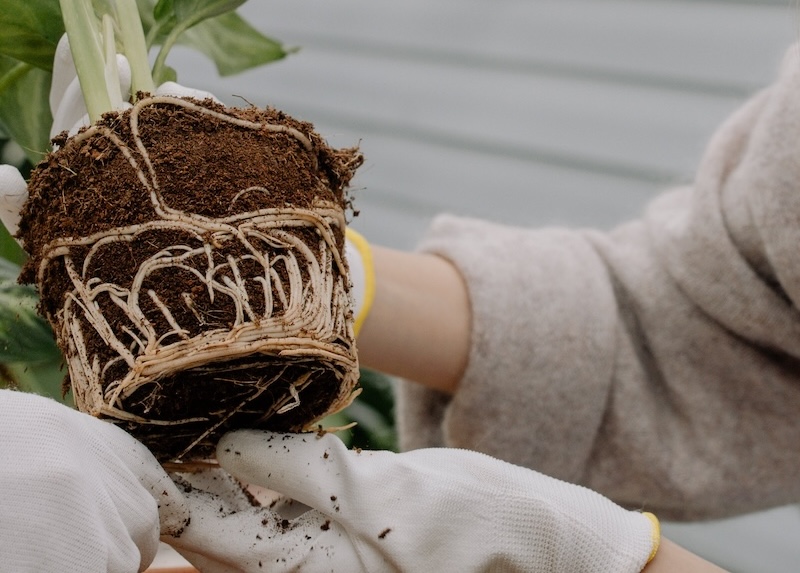Bringing a new plant home from the nursery or plant shop is always a great feeling. Deciding if your new plant needs to be upgraded to a fancy pot or can make do with the nursery pot is first on the list. As long as the nursery pot has excellent drainage, repotting may not need to be done for months. Simply sliding the grower's pot into a larger, decorative cache pot is a no-fuss way to upgrade the look of any plant. Once it settles in, Dieffenbachia can grow quickly and may need a larger home. Read on to learn how to best repot this gorgeous tropical plant.
Potting Dieffenbachia
Often houseplants sold in a plant shop or nursery have been recently potted up in fresh soil and a pot that is larger than the rootball. As long as the drainage is good, new plants will thrive for many months in their nursery pots. Always look at the root system of a new plant. Do not be afraid to gently slide the rootball from the pot. A healthy rootball should hold together loosely without roots circling the inside of the pot. If the roots are growing through the drainage holes, the plant needs a larger pot.

Choose a new pot one to two sizes larger than the rootball. Pots that are too large hold too much moisture and may cause root rot over time. Use an all-purpose potting mix that has a 1:1 ratio of soil and perlite to provide the right level of drainage and moisture retention.
Repotting Dieffenbachia
Regardless if your dieffenbachia is small or full grown, monitor its growth. The most common sign that a plant needs to be repotted is circling of the roots inside the pot. After removing the plant from its pot, gently tease apart the roots to stop them from circling the rootball. Choose a container that has excellent drainage and is no more than 1-2 sizes larger than the current pot.

Pots that become damaged over time and have holes or cracks allow too much air to reach the soil, causing the roots to dry out much quicker than normal. These pots should be discarded and replaced with a new container.
Dieffenbachia grows vigorously and will need to be repotted annually. Once the plant has reached its mature size, you will not need to completely repot the plant. Instead, remove the top 2-3 inches of potting mix and replace it with fresh media; this will give your plant the boost it needs.
Best Soil For Dieffenbachia
Dieffenbachia requires well-draining, loose soil that retains moisture but does not get soggy. Use an all-purpose indoor potting soil that has a good ratio of added perlite to aid drainage. Avoid using a mix with added gel or water-holding crystals, as these make it more difficult to determine if the soil is draining enough between waterings.
Peat-free potting mixes are preferred over those with added peat moss. Not only are peat-free soils more sustainable and better for the environment, but they also have much better drainage, which Dieffenbachia craves. Look for potting mixes with coconut coir as the main component, in addition to perlite or vermiculite to further lighten the soil and improve its water-holding ability.
Do not be tempted to use soil from your outside garden to pot up houseplants. The mix of topsoil and native soil is much too heavy for potted plants. The outdoor soil is also not sterile and may introduce fungus gnats and other pests, which can be difficult to control indoors. Mixing your own sterile potting mix is fairly easy, as all of the components are usually available in nurseries or plant shops. Our favorite mix includes 2 parts coconut coir, 1 part perlite or pumice, and 1/2 part worm castings or other organic fertilizer.

Dieffenbachia Drainage
Providing the right drainage for Dieffenbachia can mean the difference between growing a very happy, trouble-free plant or lamenting a sad, struggling plant. Only plant Dieffenbachia in pots with drainage holes, and never allow Dieffenbachia to sit in standing water. If you are using a more decorative pot as a cache pot, make sure to remove the nursery sleeve and empty any standing liquid after watering. Saucers that are used to catch overflow from watering should also be emptied after watering.
To increase humidity levels around your plant, add 1-2 inches of pea gravel or river rock to the drainage saucer. This will lift the plant's roots so that they do not sit in standing water, and allow excess moisture to evaporate naturally, providing a more humid environment.
 |
Author Robbin Small - Published 11-29-2023 |
